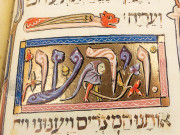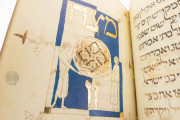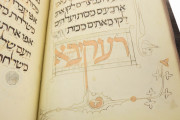The Prato Haggadah, possibly created in Spain around 1300, is a remarkable manuscript that commemorates the Exodus of the Israelites from Egypt, emphasizing their divine mission. This treasured book is central to the Passover ceremony, a Jewish feast coinciding with Easter. Its rich text includes stories from the Old Testament, legends, fables, aphorisms, psalms, sermons, and exegeses, primarily derived from oral traditions of the Second Temple period. By the fourteenth century, these traditions had been expanded, recorded, and canonized into the Haggadah we recognize today.
The Unique Blend of Sephardi and Ashkenazi Traditions
The Prato Haggadah is a distinctive example of the Sephardi rite, ending with the Hallel (Psalms 113-114, 115-118) followed by "Yehalelukha ... betishbahot." Unlike other Sephardi Haggadot, it concludes with the piyyutim "Pesach Mitzrayim" and "Mebet On," which are typically recited during Passover week rather than at the ceremony's end. An Ashkenazi scribe later added these and other piyyutim, creating an intriguing blend of Sephardi and Ashkenazi traditions.
The Book of the Most Important Men of the Middle Ages
During the thirteenth and fourteenth centuries, Jewish nobles at European royal courts sought to enhance the Haggadah with illuminated manuscripts. These private devotional books, used during the family meal marking the start of Passover, were adorned with contemporary book painting styles. The traditional ornamental designs were enriched with figurative representations, crafted to the highest artistic standards, reflecting the tastes and sophistication of their patrons.
A Demonstration of the Creation of Manuscripts
The Prato Haggadah offers a fascinating glimpse into medieval manuscript creation. It reveals the meticulous process of illumination, starting with preparatory drawings, followed by laying down gesso to cushion the gold leaf, applying gold and silver leaf, and finally adding pigments. The artist’s exceptional skill is evident in both the preliminary sketches and the finished pages, whose vibrant colors have remained brilliant. The manuscript features Square Sephardic script and Square Italo-Ashkenazic script, with forty miniatures illuminated in gold and silver, and sixty partially illuminated or only drawn.
The Illustrations of the Prato Haggadah
This unfinished manuscript provides valuable insights into the stages of medieval illumination, with most decorations remaining in the draft stage. The text and biblical illuminations are incomplete, some being mere pen drawings, while others are partially colored using blue, orange, white, green, yellow, violet, and pink, with burnished gold and silver. Human faces, hands, and some furniture are left uncolored. The manuscript features three full-page drawings for an incomplete biblical cycle, fifteen text illustrations—four of which are full-page—and numerous initial word panels. These panels are adorned with burnished gold letters set against alternating blue and pink backgrounds or painted on gold backgrounds. The margins are decorated with intricate foliate scrolls, stylized leaves, dragons, grotesques, birds, and various animals like rabbits, deer, and hounds.
We have 1 facsimile edition of the manuscript "Prato Haggadah": Prato Haggadah facsimile edition, published by Patrimonio Ediciones, 2007
Request Info / Price


























